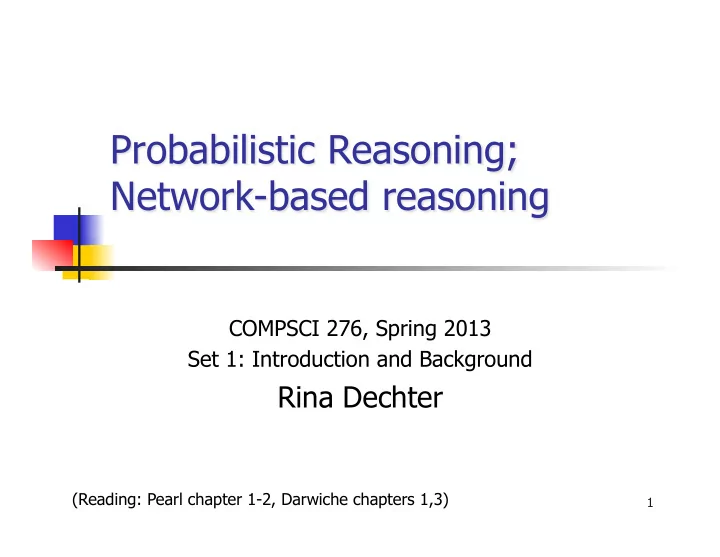

Probabilistic Reasoning; Network-based reasoning COMPSCI 276, Spring 2013 Set 1: Introduction and Background Rina Dechter (Reading: Pearl chapter 1-2, Darwiche chapters 1,3) 1
Class Description n Instructor: Rina Dechter n Days: Tuesday & Thursday n Time: 11:00 - 12:20 pm n Class page: http://www.ics.uci.edu/~dechter/courses/ics-275b/spring-13/ n 2
Outline n Why uncertainty? n Basics of probability theory and modeling 3
Why Uncertainty? AI goal: to have a declarative, model-based, framework that n allow computer system to reason. People reason with partial information n Sources of uncertainty: n Limitation in observing the world: e.g., a physician see symptoms and not n exactly what goes in the body when he performs diagnosis. Observations are noisy (test results are inaccurate) Limitation in modeling the world, n maybe the world is not deterministic. n 4
Example of common sense reasoning n Explosive noise at UCI n Parking in Cambridge n The missing garage door n Years to finish an undergrad degree in college 5
Shooting at UCI Fire- shooting crackers what is the likelihood that there was a criminal activity if S1 called? What is the probability that someone will noise call the police? Vibhav Anat call call Stud-1 call Someone calls 6
Why uncertainty n Summary of exceptions n Birds fly, smoke means fire (cannot enumerate all exceptions. n Why is it difficult? n Exception combines in intricate ways n e.g., we cannot tell from formulas how exceptions to rules interact: A à C B à C --------- A and B - à C 7
The problem All men are mortal T All penguins are birds T True … propositions Socrates is a man Men are kind p1 Birds fly p2 Uncertain T looks like a penguin propositions Turn key –> car starts P_n Q: Does T fly? Logic?....but how we handle exceptions 9 P(Q)? Probability: astronomical
Managing Uncertainty n Knowledge obtained from people is almost always loaded with uncertainty n Most rules have exceptions which one cannot afford to enumerate n Antecedent conditions are ambiguously defined or hard to satisfy precisely n First-generation expert systems combined uncertainties according to simple and uniform principle n Lead to unpredictable and counterintuitive results n Early days: logicist, new-calculist, neo-probabilist 10
Extensional vs Intensional Approaches n Extensional (e.g., Mycin, Shortliffe, 1976) certainty factors attached to rules and combine in different ways. A à B: m n Intensional , semantic-based, probabilities are attached to set of worlds. P(A|B) = m 11
Certainty combination in Mycin A x If A then C (x) z C D If B then C (y) If C then D (z) y B 1.Parallel Combination: CF(C) = x+y-xy, if x,y>0 CF(C) = (x+y)/(1-min(x,y)), x,y have different sign CF( C) = x+y+xy, if x,y<0 2. Series combination… 3.Conjunction, negation Computational desire : locality, detachment, modularity 12
The limits of modularity Deductive reasoning: modularity and detachment P à Q P à Q P à Q P K and P K à P ------- ------ K Q Q ------ Q Plausible Reasoning: violation of locality Wet à rain wet à rain Wet Sprinkler and wet -------------- ---------------------------- rain rain? 13
Violation of detachment Deductive reasoning Plausible reasoning P à Q Wet à rain K à P Sprinkler à wet K Sprinkler -------- -------------------- Q rain? 14
Burglery Example Burglery Phone Alarm call Earthquake Radio A à B A more credible IF Alarm à Burglery ------------------ A more credible (after radio) B more credible But B is less credible 15 Issue: Rule from effect to causes
Probabilistic Modeling with Joint Distributions n All frameworks for reasoning with uncertainty today are “ intentional ” model-based. All are based on the probability theory implying calculus and semantics. 21
Outline n Why uncertainty? n Basics of probability theory and modeling 22
28
29
Alpha and beta are events
Burglary is independent of Earthquake
Earthquake is independent of burglary
41
42
46
48
49
Example P(B,E,A,J,M)=? 50
51
52
53
54
Bayesian Networks: Representation P(S) Smoking BN = (G, Θ ) P(C|S) P(B|S) Bronchitis lung Cancer CPD: C B D=0 D=1 0 0 0.1 0.9 0 1 0.7 0.3 P(X|C,S) P(D|C,B) 1 0 0.8 0.2 X-ray Dyspnoea 1 1 0.9 0.1 P(S, C, B, X, D) = P(S) P(C|S) P(B|S) P(X|C,S) P(D|C,B) Conditional Independencies Efficient Representation 55
Recommend
More recommend